 |
September 30, 2010: The Much-Loved Bluebird
Mass Audubon's Ashumet Holly Wildlife Sanctuary in East Falmouth near Rt. 151 is well known for its 65 varieties of holly trees planted throughout the sanctuary and rare wildflowers that bloom in late summer. You'll find a flurry of activity near the small barn in August with resident barn swallows and colorful bluebirds. The Eastern Bluebirds can be found around the many nest boxes on the western side of the sanctuary.........read
more
 post
a comment about this photo on Mass
Audubon Wellfleet Bay Wildlife Sanctuary Facebook page post
a comment about this photo on Mass
Audubon Wellfleet Bay Wildlife Sanctuary Facebook page
|
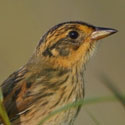 |
September 9, 2010: Saltmarsh Sharp-tailed Sparrow
For most birders, the task of identifying Sparrows is daunting and challenging! However, only a small handful of sparrows are typically found in grassy marshes. The Saltmarsh Sharp-tailed Sparrow is a common summer breeding bird in Massachusetts. This sparrow is mostly found in coastal salt marsh habitats........read
more
 post
a comment about this photo on Mass
Audubon Wellfleet Bay Wildlife Sanctuary Facebook page post
a comment about this photo on Mass
Audubon Wellfleet Bay Wildlife Sanctuary Facebook page
|
 |
August 24, 2010: Ruby-throated Hummingbird
August is perhaps the most exciting time to feed and observe Hummingbirds as their southward migration is at its peak this month. The Ruby-throated Hummingbird is the most common hummingbird on Cape Cod and is seen in gardens and at nectar feeders.......read
more
 post
a comment about this photo on Mass
Audubon Wellfleet Bay Wildlife Sanctuary Facebook page post
a comment about this photo on Mass
Audubon Wellfleet Bay Wildlife Sanctuary Facebook page
|
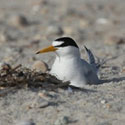 |
August 16, 2010: A Prized Cape Resident--the Least Tern
On many protected barrier beaches you may find Least Terns feeding and raising their new chicks alongside Piping Plovers. Their nests usually consist of a shallow scrape on a sandy beach. Least Terns are the smallest terns and have gray upperparts, white underparts, a black cap and nape, a white forehead, and an orange-yellow bill with a dark tip......read
more
 post
a comment about this photo on Mass
Audubon Wellfleet Bay Wildlife Sanctuary Facebook page post
a comment about this photo on Mass
Audubon Wellfleet Bay Wildlife Sanctuary Facebook page
|
 |
July 15, 2010: Ruddy Turnstone
The Ruddy Turnstone is a compact shorebird with distinctive plumages and bright orange legs. It has a Rt1 short, wedge-shaped dark bill that it uses in its unique foraging style. This male was found recently at Wood Neck Beach in Falmouth.....read
more
 post
a comment about this photo on Mass
Audubon Wellfleet Bay Wildlife Sanctuary Facebook page post
a comment about this photo on Mass
Audubon Wellfleet Bay Wildlife Sanctuary Facebook page
|
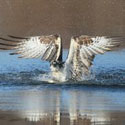 |
May 6, 2010: Ospreys
A tasty inflight meal! An Osprey snags some fast food from Oyster Pond in Falmouth. Springtime means ospreys have returned in full force to their nests all over Cape Cod. Massachusetts Audubon’s Wellfleet Bay is now tracking more than 200 active nests of breeding pairs of osprey all over the Cape. The fish-eating birds of prey are best known for their spectacular hunting style: They dive headfirst into lakes, rivers, and bays after hovering above the water’s surface to target their prey, which they then take to a nearby nest or perch to eat....read
more |
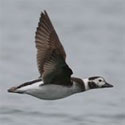 |
March 15, 2010: Cape Winter Residents--Long-Tailed Ducks
The Long-tailed Duck is frequently found in offshore waters around
Cape Cod and Nantucket during the winters but breeds in the Arctic
region during the summer months. The Long-tailed Duck was formerly
known as the Oldsquaw. The long tail refers to a pair of elongated
black tail feathers that stream behind the male ducks as they fly...read
more
 post
a comment about this photo on Mass
Audubon Wellfleet Bay Wildlife Sanctuary Facebook page post
a comment about this photo on Mass
Audubon Wellfleet Bay Wildlife Sanctuary Facebook page
|
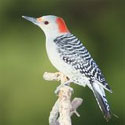 |
March 05, 2010:
Red-Bellied Woodpecker
The Red-bellied Woodpecker is frequently heard and seen on tree trunks
as well as at seed and suet feeders in backyards, especially during
the winter months. It is increasingly common on Cape Cod making noisy
vocalizations and drumming sounds in breeding season. This attractive
woodpecker can be identified by its red crown and nape along with
a fairly long bill...read
more
 post
a comment about this photo on Mass
Audubon Wellfleet Bay Wildlife Sanctuary Facebook page post
a comment about this photo on Mass
Audubon Wellfleet Bay Wildlife Sanctuary Facebook page
|
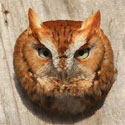 |
February 19, 2010:
Screech Owl Residing in Falmouth Backyard
This Eastern Screech Owl (red phase) has made its home in a local
backyard nesting box in West Falmouth. This adult owl is a striking
reddish brown overall with streaked underparts, yellow eyes, pale
grayish bill and short “ear” tufts. The Eastern Screech
Owl species has two distinct color phases, red and gray. The red
phase is less common than the gray phase...read more
 post a comment about this photo on Mass
Audubon Wellfleet Bay Wildlife Sanctuary Facebook page post a comment about this photo on Mass
Audubon Wellfleet Bay Wildlife Sanctuary Facebook page
|
 |
February 2, 2010: An Unusual Canvasback Sighting
While checking out the local wintering ducks around Perch Pond
off of Teaticket Path in East Falmouth, a pleasant surprise popped
up. A single male Canvasback duck was moving around in open water
and near the ice pack. The Canvasback is a large diving duck and
rarely found close to shore. According to Wayne Petersen in Birds
of New England, “Canvasbacks are typically found on large
areas of open water and birders are often forced to admire them
from a distance.” Canvasbacks frequently move around to
different locations based on ice conditions and food supply...read
more |
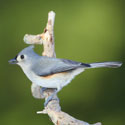 |
January
21, 2010: Focus on Feeders, Feb. 6 & 7 2010
In backyards all over Cape Cod bird feeding has become a very popular winter
activity. According to recent studies, over 40% of Cape Cod residents feed
and closely watch birds and wildlife. As a result of this, Mass Audubon has
been promoting backyard bird feeder surveys for over 40 years. Observations
from these surveys have contributed in a big way to improved understanding
of critical trends and patterns in bird life...read
more |
 |
November 5, 2009: Harlequin Duck
According to Birds of North America online “this sea duck
occupies a niche that is unique among North American waterfowl.
The Harlequin Duck uses clear, fast-flowing rivers and streams
for breeding and is able to move swiftly and with great agility
in turbulent white water, diving to river bottoms to feed...”
These images were captured on Sun. Nov. 1, 2009 at Scusset Beach
State Reservation located in Sandwich. Skies were overcast with
light winds...read
more |
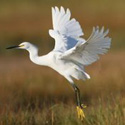 |
October 13, 2009:
Egrets, I've Had A Few!
Snowy Egrets are staging in growing numbers along with Great Egrets
in many salt marsh locations on the Cape. With the nesting season
over, they are preparing for migration to Central and South America.
The beautiful snow white plumage provides a striking contrast from
the marsh grass in the early morning light at Great Sippewissett
Marsh...read more |
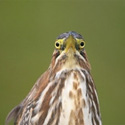 |
October 6, 2009: Green Heron
The Green Heron is one of the smaller wading birds. The Green Heron
is very difficult to locate and observe. It is darkly colored and
about the size of crow. It is mostly a solitary and secretive bird
and most often found around dawn and dusk. The Green Heron is found
in saltwater and freshwater wetlands, marshes, ponds and streams
with thick vegetation. Green Herons typically stand quietly and
still in shallow water or perch upon branches to find and strike
their prey. They usually feed on small fish. Green Herons have
a tendency to fly away from a disturbance while making a loud squawking
noise...read more |
 |
September 17, 2009: Semipalmated Plover
The Semipalmated Plover is probably the most common small plover
on Cape Cod. These plovers gather in loose flocks during fall migration
on open mudflats and sandy beaches. They are noted for their run
and stop feeding style. They have a high pitched, two part whistled
call that sounds like “chu-wee.” This plover is easy
to identify with a single dark breast band, a black-tipped orange
bill, long orange legs along with white underparts and dark brown
upperparts...read more |
 |
August 10, 2009: The Common Tern
Common Terns are very active breeding and feeding all over Cape
Cod! They typically arrive back to the Cape in late April and remain
until around September before heading south to Central and South
America. Common Terns breed in large colonies and are widespread
on sandy spits and beaches along the coast on the Cape. These terns
are noted for hovering over water and then plunge diving after
a variety of small fish. The Common Tern has a black cap, light
gray upper parts, paler gray under parts, orange legs and feet
and a black tipped orange bill. Major breeding colonies can be
found nearby on Monomoy Island in Chatham as well as Bird Island
in Marion and Ram Island near Mattapoisett...read
more |
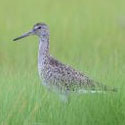 |
June
23, 2009: The Willet
The Willet is a larger sized grayish brown colored shorebird. The
Willet is a familiar sight on beaches and in salt marshes all along
the coast of Cape Cod. This shorebird is fairly abundant on the
Cape with a loud and distinctive call in flight...read
more |
 |
May
30, 2009: American Oystercatcher
The American Oystercatcher is a very distinctive looking shorebird.
The Oystercatcher is usually seen only in marine environments along
pebbly or sandy coastlines. These shorebirds have a black head, a
brownish back and white under parts. In addition, they have yellow
eyes, and a long red-orange bill that is laterally compressed and
very sharp. They are quite wary and fly away quickly when approached...read
more |
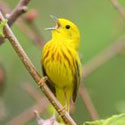 |
May 14, 2009: The
Warblers of Spring
This Yellow Warbler was practicing its dance step
near the shore of Quissett Harbor early Saturday afternoon. Warblers
are small active birds in constant motion. Yellow Warblers are among
the first wave of Warblers to arrive on Cape Cod in early May...read
more |
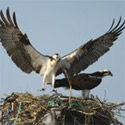 |
April
13, 2009: Expert to Speak on Ospreys of Cape Cod
The return of the osprey
is one of the greatest conservation stories of the last 30 years.
In the early 1970s there were as few as 10 nesting pairs of these
fish-eating birds of prey in Massachusetts due to the impact of
the use of pesticides like DDT, which caused their eggshells to
thin and crack. Now, numbers of breeding ospreys in Massachusetts
have rebounded strongly since the depths of the pesticide years
with levels now approaching those known historically (300+ pairs).
Cape Cod has also seen resurgence with over 160 estimated pairs
now nesting here and growing! Osprey researcher and Editor of Birds
of North America Online, Dr. Alan Poole will highlight these successes
in a lecture on Friday, April 17 at 7 p.m. at the Wellfleet Bay
Wildlife Sanctuary...read more |
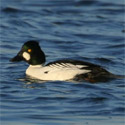 |
March 20, 2009: The Common Goldeneye
The Common Goldeneye is one of the active diving ducks. These
sea ducks may also be found in bays, lakes, or rivers. They eat
mostly small aquatic animals and a variety of small plants. The
male has a white body with a black back and tail ends as well as
an iridescent black and green head. It has a round white spot at
the base of the bill on its cheek. It has yellow eyes and a sloped
forehead. The bill color is mostly black. This photo of a male
Goldeneye was taken at Salt Pond in Falmouth...read more |
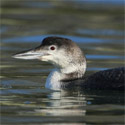 |
March 05, 2009:
The Common Loon
This is a great time to keep an eye out for wintering Common Loons.
During this time of year the nonbreeding Common Loon can be seen
hanging out in local harbors and other saltwater waterways around
the Cape including the Cape Cod Canal and further offshore. The Canal
is right in the middle of their spring and fall migration route which
usually keeps them close to the mainland. The wintering Common Loon
typically measures 2.5 to 3 feet in overall length and a wingspan
from 4 to 5 feet. The wintering Loon shows a long body that typically
sits very low in the water...read more |
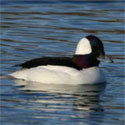 |
February
18, 2009: Bufflehead
The Bufflehead is a common sight on Cape Cod during the winter. You will find
these wintering ducks on lakes harbors and bays. They are usually found in small
flocks. They are small and bob around quite a bit. The Bufflehead is small and
measure about 13-15 inches in overall length. The bufflehead is one of the most
active diving ducks. Diving ducks feed themselves by diving underwater and searching
for plants, shellfish and fish...read
more |
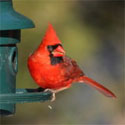 |
February
3, 2009: Focus on Feeders Weekend
Backyard birding has become such a pleasant way to enjoy nature over the last
few years. Feeders across Cape Cod have been filled with all kinds of avian visitors
this winter. Here is a sampling of backyard bird feeder photos with each species
identified to get you started!...read
more |
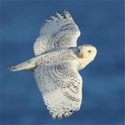 |
January
05, 2009: Snowy Owls...Another Wave?
Snowy Owl sightings continue up and down the northeast coast with many sightings
on Cape Cod and the Islands. The recent online postings made on the Mass Audubon
Bird Sightings list for the Cape show a Snowy Owl sighting in Truro as part of
the Christmas Bird Count and another at South Cape Beach in Mashpee. Thanks to
the Cape Cod Bird Club online postings many of us were alerted to the Snowy Owl
in the dunes at South Cape Beach State Park in Mashpee which is a component of
the Waquoit Bay National Estuarine Research Reserve . With camera and binocs
in hand, I trudged out through the dunes in search of the Snowy...read
more |
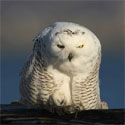 |
December
09, 2008: The Beautiful Snowy Owl
Snowy Owls are popping up all over Eastern Mass and Cape Cod. Initial sightings
in November were recently made on Plum Island followed by Crane’s Beach,
Deer Island in Winthrop, Logan Airport, Point of Pines in Revere, behind the
Walmart in Lynn, the Nahant Causeway, Duxbury Beach, Green Island in the outer
Boston Harbor Islands, a cornfield in Lincoln, Norton’s Point on Martha’s
Vineyard and Lighthouse Beach in West Dennis...read
more |
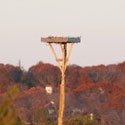 |
Nov.
17, 2008: Osprey Network Update - November 2008
As the foliage works it final magic on Cape Cod and the last of the Ospreys head
south, it is time to start enjoying the wintering ducks in the many lakes, ponds
and bays around the Cape. Last weekend, my sister, Emily and I headed out for
a kayaking adventure to Washburn Island in Waquoit Bay...read
more |
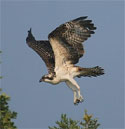 |
Oct.
15, 2008: Late Season Osprey Action
By the end of September we had located 163 osprey nests, and we were still counting!
We had several great sightings in late summer and early fall. Thanks to all the
Osprey Network volunteers who’ve helped! In the midst of an August early
morning kayak trip around Hadley Harbor on Naushon Island...read
more |
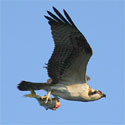 |
Oct.
4, 2008: The Cape Cod Osprey Network
After moving into a summer home in Woods Hole in the spring of 2004, we started
to regularly observe a neighborhood Osprey nest in Quissett Harbor. From time
to time, both adults and juveniles would perch on a branch outside our bedroom
window with captured fish in their talons...read
more |
 |
Sept.
7, 2008: Where in the World is Goody Hallet?
Wellfleet Bay Wildlife Sanctuary’s Cape Cod Osprey Project has a high-tech
new star – Goody Hallet. With funding generously provided by osprey aficionado
Craig Gibson, Rob Bierregaard of UNC-Charlotte put a satellite transmitter on
an Eastham Osprey, a juvenile female newly named for the legendary young Eastham
woman condemned as a witch...read
more |

